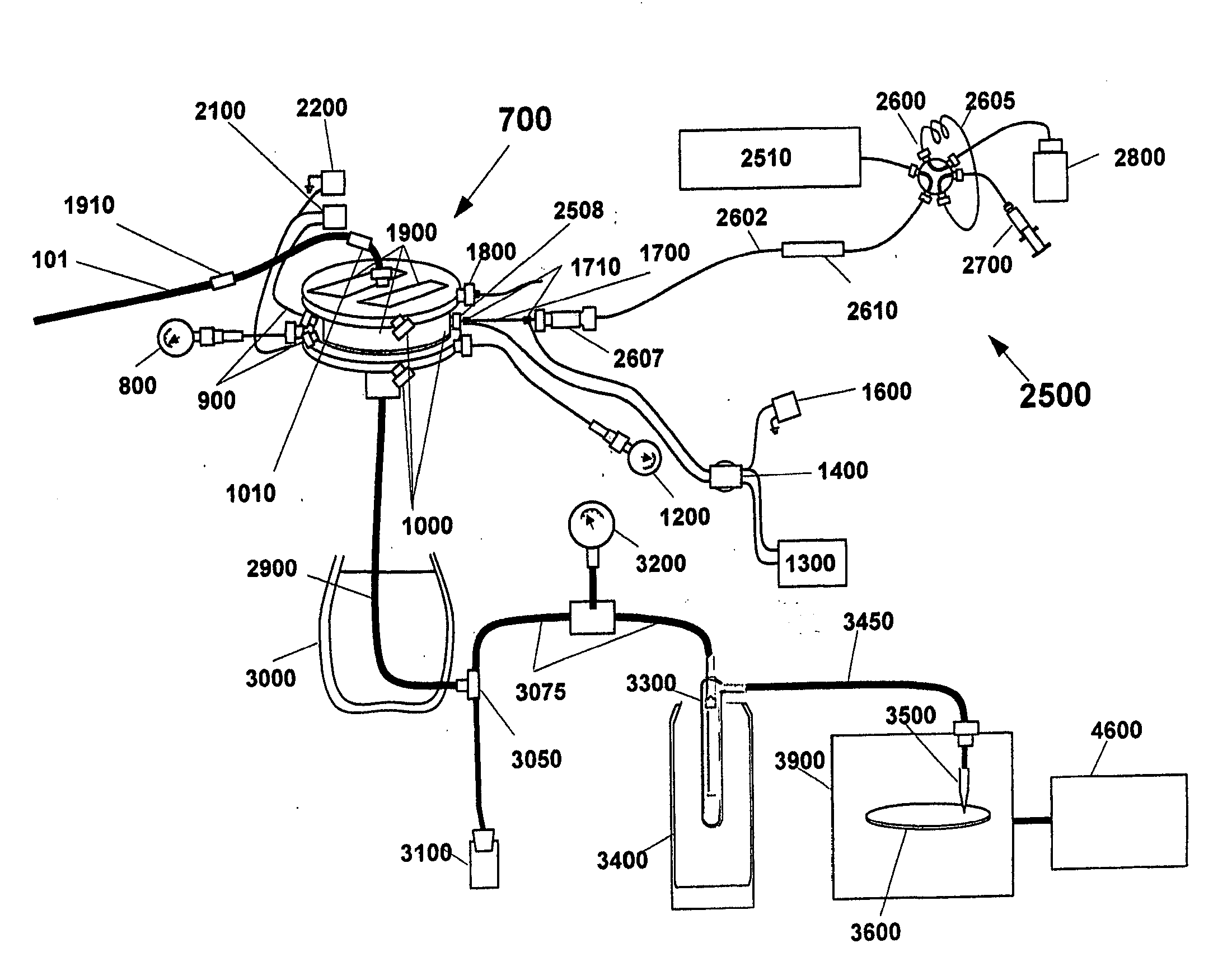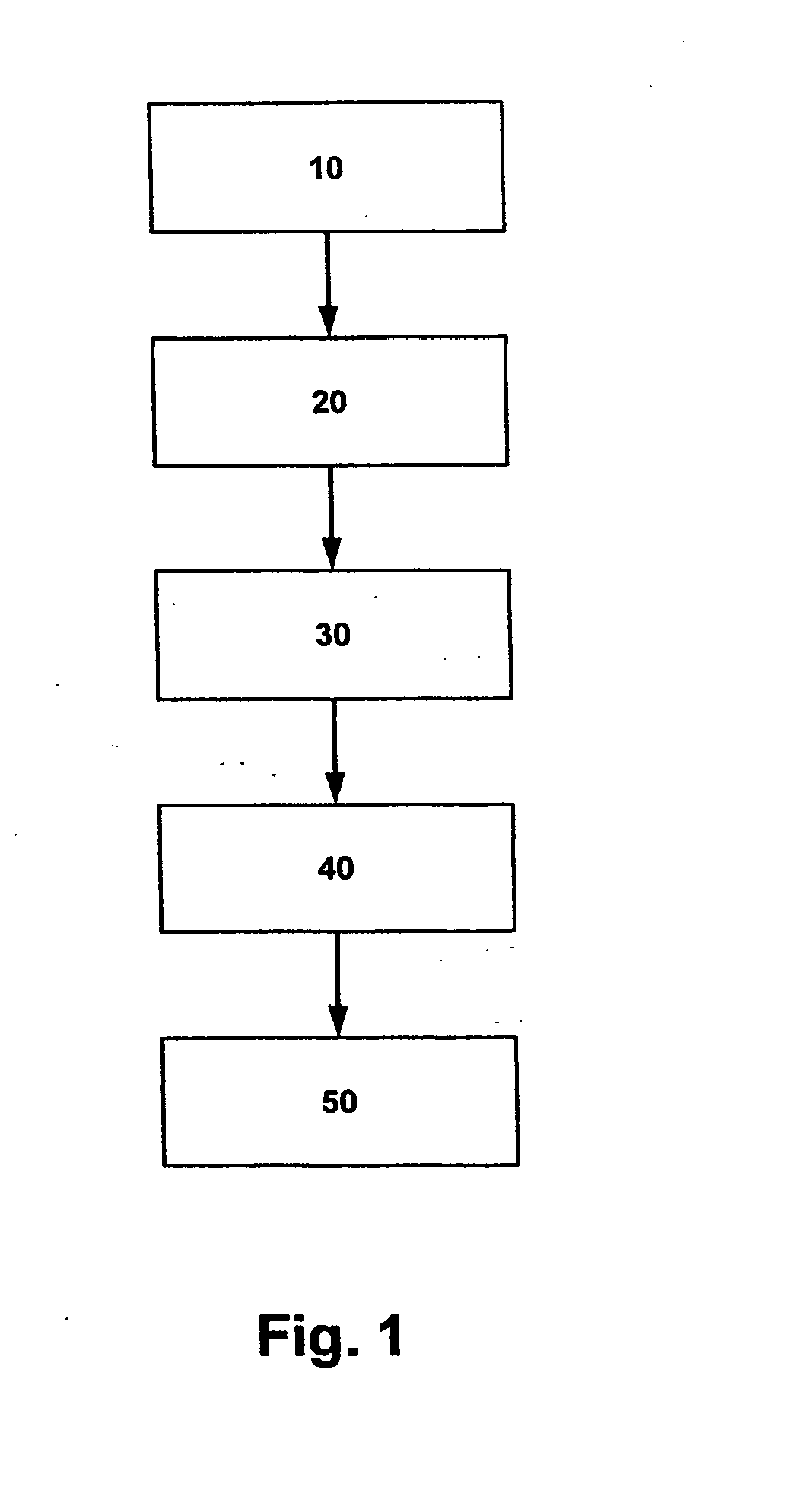[0018]Accordingly, it is a principal object of this invention to provide improved treatment techniques and apparatus for desolvating flowing liquid streams containing one or more solutes while retaining the chemical and
structural integrity and temporal separation of such solutes.
[0021]The novel spray drier
system of this invention comprises in part a
nebulizer which converts the liquid
stream into a high speed
aerosol jet which can then be directed circumferentially around the inside surface of a hot, generally cylindrical cavity of a chamber. As used herein, the term “
aerosol” is hereby defined to include liquid droplets and / or
solid particles suspended or entrained in a gas-phase fluid.
Centrifugal force, which can be provided by the
jet velocity, causes the larger liquid droplets to travel along the outer
diameter of the cavity. The cavity inner surface is heated to a temperature of at least 20° C., preferably at least 50° C., more preferably at least 100° C., above the
boiling point of the liquid component of the fluid
stream, to cause the droplets approaching that surface to “film boil.” Film boiling rapidly evaporates solvent from the droplets. In film boiling, the rapid release of freshly evaporated
solvent vapor creates a gas layer adjacent the heated surface that prevents droplet contact with the
cavity wall, thereby retaining the solute in the droplets. To ensure that the phenomenon of “film boiling” occurs in the chamber cavity, the heated inner surface of the cavity should be maintained at a temperature that is at least 20° C., preferably at least 50° C., and more preferably at least 100° C., hotter than the
boiling point of the liquid component of the fluid stream being treated. The solute is protected from
thermal damage by the combination of a short
residence time and by being inside the droplet, which is cooled by
solvent evaporation.
[0022]When the droplets have evaporated to a sufficiently small size, Stokes drag forces from the exiting
solvent vapor will exceed the
centrifugal force and carry the droplets out of the chamber, for example along the central axis of the cylindrical cavity. For convenience, the term “
cyclone” will be used herein for the chamber / cylindrical cavity
assembly as described above. After the droplets leave the
cyclone inner surface, heat exchange with the superheated solvent vapor further dries the droplets. If not already present, a small amount of non-condensable gas may be added. This added gas helps to maintain the dried droplets in an
aerosol suspension during and after the removal of solvent vapor.
Solvent vapor is removed by condensation onto a cooled surface in a first-stage condenser unit Operating this first-stage condenser unit above the
freezing point of the solvent produces a liquid condensate that can be continuously drained. The amount of remaining solvent vapor may be further reduced by an optional second condenser stage operated at a lower temperature than the first-stage condenser unit A solvent freeze point
reducing agent, such as
methanol, may be added to the second condenser stage. For a preferred chromatographic application, the dried droplet aerosol suspension flows through an orifice that focuses the dried droplets into a
narrow beam. An
optical surface is placed under the beam to collect the solute. The deposition surface is typically positioned in an evacuated chamber and is temperature controlled to condense or freeze liquid solutes while preventing condensation or allowing sublimation of any
residual solvent. To prevent “bouncing” of the dried particle off of the optical surface, a solvent or other adhesion-improving agent may be added to the deposition region. The optical surface is then moved into the focus of the infrared
microscope beam for analysis of the solute collected on the surface.
[0023]The following discussion is intended to convey the inventors' present understanding concerning how this invention operates, but such discussion should not be interpreted to limit the validity or scope of the claims. Much of the uniqueness and
advantage of the cyclone apparatus of this invention is its ability to accept a wide range of starting droplet sizes, and to automatically by virtue of its operation deliver only enough heat to each droplet as needed to evaporate the predominant portion of the solvent in each droplet Evaporative cooling effects with this apparatus limit the maximum droplet temperature to roughly the solvent
boiling point at the cyclone operating pressure. Each individual droplet remains in the cyclone only long enough to shrink to a relatively uniform and very small size. Because the
residence time of a droplet in the cyclone is inversely related to the
staring droplet size, the result is minimal
exposure of each droplet to high temperature, potentially thermally degrading or volatile-solute evaporating conditions. The balance between opposing
centrifugal force and the drag forces within the cyclone from the exiting solvent vapor determines what that
droplet size will be. The concentrated droplets are removed from proximity to the cyclone surface while they still contain a relatively small amount of solvent. Because the exiting droplets have a relatively narrow homogeneous size distribution, the amount of additional heat required to thereafter complete the evaporative removal of
residual solvent is similar for each droplet
Heat transfer from the super heated solvent vapor in this
system provides this relatively uniform additional amount of heat to effectively complete the
evaporation process. At the same time
evaporation of this residual solvent continues to protect the sample (solute) for most of this
drying step. Because the droplets are already leaving the cyclone before they can reach full
dryness, the duration of droplet
exposure to conditions without evaporative cooling protection is minimal thereby minimizing opportunities for thermal degradation of the sample.
[0139]This invention is based on the principle that a flowing fluid stream can be treated according to the invention to produce a treated flowing gas stream that carries the originally dissolved components (solutes) as particulate matter, but at a
mass concentration substantially higher, e.g., a 10 fold increase in concentration, than that in the original fluid stream. The invention thus enables further
processing of the particulate stream, especially types of
processing that would be rendered difficult or impossible by the continued presence of the liquid. One example of such further
processing which is facilitated by this invention involves directing the particulate stream onto a window or another optically transparent or translucent surface or onto a porous surface such as a
porous membrane, where the particulate matter collects in a configuration which is favorable for observation, for example by an infrared
spectrometer using
microscope optics. Another example of such further processing that is facilitated by this invention involves directing the particulate stream through a
reaction chamber, and thence into a
detector designed for
gas chromatography, thus allowing the application of
gas chromatography detectors to liquid chromatography eluents.
 Login to View More
Login to View More 


